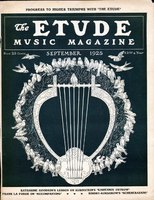By the Noted American Pianist-Composer—Accompanist and Teacher
FRANK LA FORGE
FRANK LA FORGE was born at Rockford, Illinois, October twenty-second, 1879. He studied with Harrison M. Wild in Chicago and with Leschetizky, Labor and Navrátil in Vienna. For six years he was the exclusive accompanist of Mme. Marcella Sembrich on her tours of Germany, France, Russia and the United States. He has composed many exceedingly beautiful songs. As an accompanist he is unexcelled. He is the teacher of the sensationally successful Metropolitan Opera Company star of last season, Lawrence Tibbett.
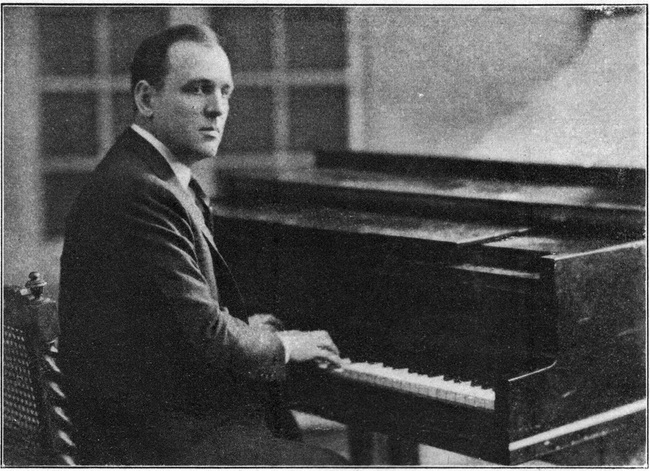 THE art of accompanying is one of the most difficult to master. The old idea that anyone who was a somewhat indifferent soloist might eke out a livelihood at accompanying has long since been abandoned in higher musical circles. The accompanist must be a master musician with quick wit, splendid judgment, extensive experience and a really very great digital technic. More than this he must have a chameleonlike mind to fit his mood instantly to that of others who employ his services.
THE art of accompanying is one of the most difficult to master. The old idea that anyone who was a somewhat indifferent soloist might eke out a livelihood at accompanying has long since been abandoned in higher musical circles. The accompanist must be a master musician with quick wit, splendid judgment, extensive experience and a really very great digital technic. More than this he must have a chameleonlike mind to fit his mood instantly to that of others who employ his services.
NOT MORE than a decade ago musicians were inclined to regard accompanying as an activity of minor importance. It was considered a useful accomplishment to have; but for a serious artist to devote his major effort to this phase of the art was scarcely to be thought of. Even Leschetizky, with whom I studied for four years, regretted my ultimate decision to become an accompanist—for I had studied as a soloist with him—and he strongly advised me against it. He shared the prevalent view of that time that accompanying should be a minor and not a major pursuit. Some years later, however, he changed his viewpoint, when I appeared as accompanist to Mme. Sembrich at concerts in Vienna, and told me that he could see in accompanying a great art, an art worthy of the best efforts of any serious pianist.
The advancement in the art of accompanying has been notable in the last ten years. It is now regarded more seriously than formerly, by professional musicians and public alike. There are many more singers and other soloists at the present time and a correspondingly greater need for accompanists. When formerly a mediocre performance on the part of the accompanist was acceptable, the standards of the profession are now much higher and the field broader. Pianists and students are finding it to their advantage to cultivate the art either as an adjunct to their solo playing or as a specialty. And accompaniment-playing will prove beneficial to the soloist, because it will acquaint him with some principles of ensemble playing which every well rounded pianist needs to know.
To my mind, the accompanist who has a thorough command of the resources of his art compares very favorably with the orchestra conductor. Toscanini, for instance, has a more comprehensive knowledge of the opera he is conducting than the individual members comprising his company. The latter are as blocks in a mosaic, disassociated parts. It remains for Toscanini to weld these blocks into a finished and beautiful whole. An old axiom in geometry comes to mind—a whole is greater than any of its parts. Accordingly Toscanini must have a more extensive equipment than the individual members of his company. The same can be said with respect to the accompanist. He should know, for instance, more about the song than the singer who sings it. The latter centers attention upon the melody while the former must not only know the melody and words but also supply the harmonic investiture as well. While he does not conduct the performance in the sense that Toscanini does, yet he must have a knowledge of the whole; while the average singer usually has knowledge only of his part. Thus it is apparent how extensive the art becomes to anyone who would study it seriously.
In studying a song, all my pupils, both of singing and of accompaniment, go through the same procedure. An outline of that procedure might help the pianist to get some practical hints for playing an accompaniment artistically.
What then is the first thing to do in learning to play an accompaniment? The usual reply to this query is that the player should take up the piano part and study it. As a matter of fact, this is the last thing to do. As previously stated, the intelligent accompanist should make a greater study of the song than the singer. The former should begin his task just where the composer began—with the words or poem. The composer got his inspiration from the poem and then set his thought to music. Accordingly, begin every song in this way, going over the words, getting the feel of them, finding out the sentiment expressed, locating the high lights, the shadows, the climaxes, and finally committing the words to memory. Some composers, notably Schubert, gave very few indications of how a song should be played or sung. A melody sprang into Schubert’s consciousness almost as a full-blown flower. He was one of our most spontaneous composers, committing his thoughts to paper hastily, and quite frequently forgetting about them afterwards. Beethoven, on the other hand, worked with meticulous care, refining, polishing, bringing to his task the spirit of the craftsman. He gave more indications as to interpretation. His notebook, showing the developing process of his themes, is to-day the most valuable treasure that exists for students of composition. Composers may be spontaneous in evolving their creations or they may work slowly, depending on their particular type of temperament. The point remains, however, that an understanding of the inner meaning of the words gives the best clue to the song’s interpretation, aside from indications.
The next step of the composer is to fit his melody to the words. Accordingly, after committing the words to memory, learn the melody, playing it as a unison with both hands and beating the time with your foot. In this way the rhythm and melody soon become, ingrained in your sub-conscious mind. Lawrence Tibbett, who studies with me, works out his entire repertoire in this manner.
After achieving the first and second steps, the player has laid a solid foundation for building the accompaniment, which is the third and final step. He can now work out the details of the accompaniment logically and intelligently.
In addition to the words, I commit all my accompaniments to memory and my present repertoire consists of over three thousand songs. Memorization is a decided asset, but I advise it only for those whose memory is dependable and facile. Personally I believe that if the ear memory is cultivated from the beginning of study, almost anyone can develop a reliable memory. To be able to divorce himself from notes is a great advantage to the accompanist. He is then able to watch the singer closely and anticipate his every nuance.
To proceed then with the final step, working out the details of the accompaniment. There are two details here to be noted that make the difference between the mediocre and the finished, artistic performance. I have heretofore alluded to the singer because vocal accompanying is more frequently encountered. However, there are violinists and others to be considered. The procedure as previously outlined, with the exception of learning the words, applies to all forms of accompaniment playing. In accompanying violinists and other stringed instrument players, the physical limitations of the soloist impose fewer obstacles. The singer, however, must breathe, a fact to be borne in mind by the accompanist. Notable concessions must be made for breathing and the accompanist should know when and where. If the singer, for instance, sings a long phrase, the breath supply is gradually depleted. Consequently the singer must not only recover from the exhaustion of that phrase but take breath again for the next. Invariably unless the accompanist senses these situations, he will rush ahead of the singer before the latter has sufficiently recovered to resume. The following illustration from Schumann’s Er, der Herrlichste von Allen (He, the Best of All) from “Woman’s Life and Love,” is a case in point.
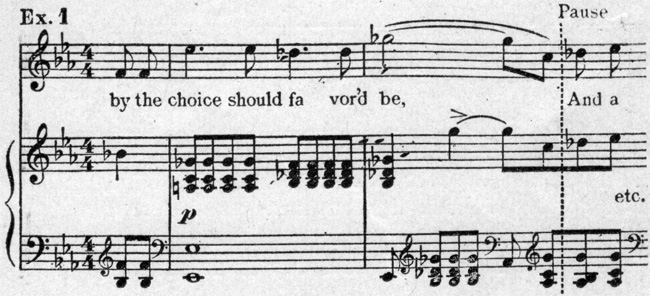
In this instance, unless the accompanist knows that breath should be taken, necessitating a pause immediately following C, he will continue in tempo ahead of the singer, thus causing confusion. Such instances (where the composition allows no natural breathing places—rests or pauses) require a constant rubato on the part of the accompanist. Free from notes, the latter is able to watch the lips of the singer, to sense such situations, and to feel the nuance. Otherwise he should mark all important breathing places, particularly where the singer must recover from a long phrase.
The second consideration in working out the accompaniment puts the final stamp of distinction on a performance. Let me illustrate this point in Schumann’s The Ring, from ”Woman’s Life and Love.”
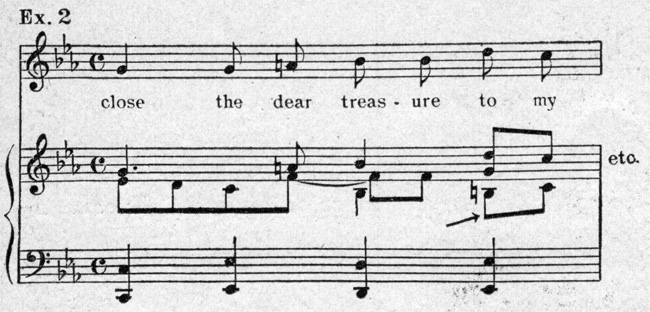
How would you play the rolled chord; B-natural, G, D on the fourth beat? I can hear you playing it as it is done invariably by my pupils at first, emphasizing the melody note, D. True, in solo playing we emphasize the melody note. But in accompanying, when the melody note occurs both in the accompaniment and song, why should it be emphasized twice? The singer brings out the melody and thereby gives us opportunity of giving prominence to another note or voice, thus making a little duo. Now play the chord bringing out the B natural and see what a difference it makes.
Let us consider the opening measures of The Ring as a further exemplification of this principle.
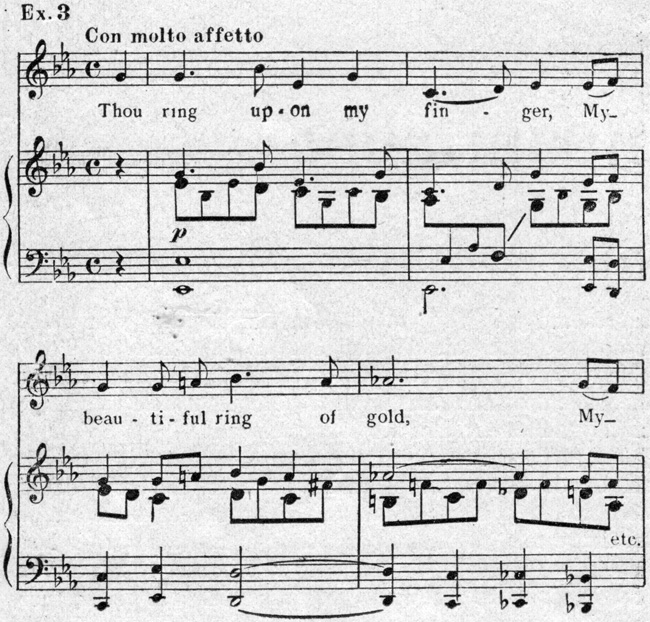
Here the accompaniment doubles the melody. Play it over, first emphasizing the melody. Then play it allowing the singer to stress the melody and bring out the larger notes. You will now begin to perceive into what a fascinating interplay of voices such a study will lead you. I would like to cite one other example from The Ring (Ex. 4), because everyone who hears this played one way and then the other exclaims upon the difference.
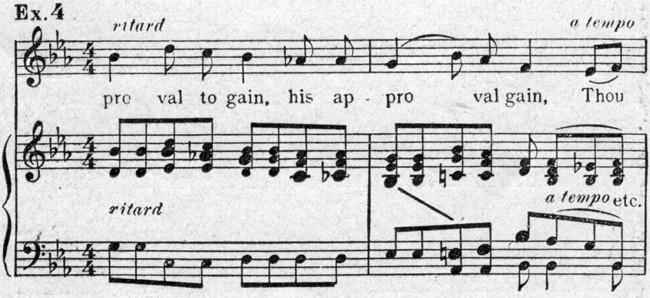
In this example, also, the melody is duplicated in the accompaniment. Play it over, first stressing the melody and then play it over bringing to the fore the larger- sized notes. To one unaccustomed to differentiation of note dynamics, bringing out a note in the middle of a chord is not so easy. The study is an intensely profitable one, however, for any pianist to make, as it opens up a whole new world of note and color values. As an accompanist, in bringing out the inner voices, you become more than a mere accessory to the singer. You become, in reality, a part of an ensemble, interweaving little skeins of melody here and there and achieving a beautiful and variegated pattern. This phase of the subject itself is too vast to admit of detailed treatment here. Suffice it to offer a few more suggestions for your guidance.
Whenever the accompaniment doubles the melody of the song, search out the hidden voices and give them prominence. Accompaniments have the following elements in greater or less proportion: melody, rhythm, fundamental bass, intermediate parts that move and intermediate parts that remain stationary. Examples 3 and 4 have the first four elements, and since the intermediate parts move, we select some of them for stress. As a general rule, a moving part (one that moves up or down in a melodic way) other than the melody, offers opportunity for counterpoint. Frequently the bass can be given prominence, as in Schubert’s Who is Sylvia?
Another principle for the accompanist to remember is that good taste abhors monotony. Ex. 5 is a
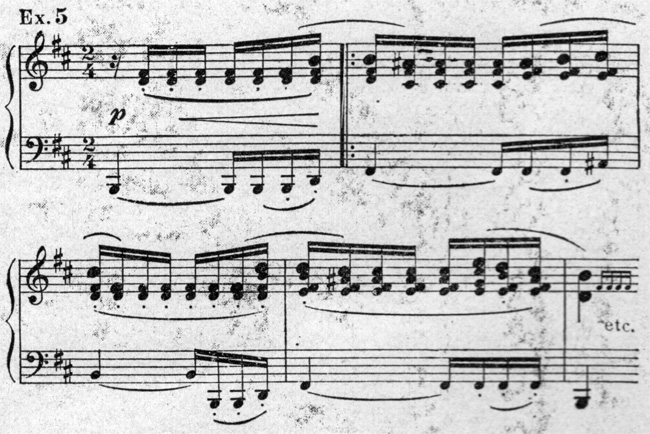
prelude to Schubert’s The Favorite Color from “The Maid of the Mill.” The right hand begins with repeated thirds. Now repeated notes lose interest unless working up to a climax or down to a vanishing point. If they are doing neither, they should be greatly subdued. Accordingly this prelude is to be played, each note with the same subdued regularity until the motion occurs (F sharp to B), which is then treated melodically until it becomes stationary on A-sharp. The same process repeats itself as indicated by the larger notes. The first notes of the phrase, showing a movement of voices, are emphasized and the top melody note brought out. Thus throughout the example is phrased as shown.
A song’s prelude is its introduction. Preludes and postludes, as well as interludes, are bits of solo playing. They should be played accordingly with solo tone, emphasizing the melody and with the prominence of solos. A prelude announces the song and frequently establishes its mood. It is of importance to study preludes, postludes and interludes with care to exhaust their possibilities.
Finally, the accompanist should strive to reflect the atmosphere of the song. All the more reason why he should get the inner meaning of the words. Does the song suggest the delicacy of snowflakes, the surge of the sea, the buoyancy of a brooklet, the heartache of despair, or is it descriptive, as in Schubert’s Gretchen am Spinnrad? Whatever its spirit, mirror it in the accompaniment.
For purposes of illustration, consider “The Maid of the Mill,” the song cycle by Schubert. First read the text of the entire cycle in order to get a panoramic view of the entire situation. Then the “close up.” The first song, “Wandering,” discloses the miller to be a man fond of wandering and ever active as is his mill wheel. This restless activity is admirably suggested in an accompaniment of sixteenth notes. Since rhythm is the chief characteristic of this accompaniment, much should be made of it, with clear accents. The next song, Whither? also portrays in its setting some of the restless whirring of the mill-wheel, whose motion is suggested by swift, light-moving sixteenth notes in the right hand. Thus each song portrays a different mood. In the one After Work, the young miller is deeply stirred and filled with longing to do mighty deeds to prove his love for the miller maid. When the accompanist senses this feeling himself he can depict in the opening chords the impatient abandon of the song. The vital thing is to get the spirit of the song, to feel the emotions of its characters, and then to disclose these emotions in the accompaniment. That is why it is so essential to study the song as a whole, and not simply to learn to play the piano part.
One other consideration is to be borne in mind. The resonance of sopranos and tenors particularly is much greater in the upper than in the lower registers. Accordingly, when low notes are sung they are usually not heard as distinctly as higher ones, and the accompanist should subdue the piano part to the degree that will give the singer prominence. Even, when printed indications seem to give directions to the contrary, your own good taste and judgment should decide when to submerge your part so that the singer can be heard. For the accompanist, as well as for anyone else, common sense has a current market value.
To recapitulate; in accompanying songs, first find out the meaning of the words convey, then acquire the melody and rhythm, and finally study out the accompaniment, remembering the two important considerations—to mark the breathing places and to bring out, when possible, the little counter voices that illuminate the harmony. This done, you will have mastered the song thoroughly, you will be able to give the singer the utmost cooperation and your work can scarcely fail to attain that noticeable distinction associated with true artistry.
Self-Test Questions Upon Mr. La Forge’s Article
1. How have the standards of accompanying advanced?
2. What is the first thing to do in learning to play an accompaniment?
3. How can one get a melody ingrained in the subconscious mind?
4. How does accompanying a violinist differ from accompanying a singer?
5. When should the accompaniment be submerged?


